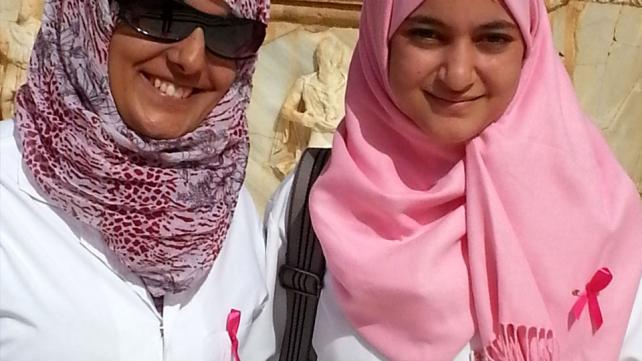
Breast cancer is the most common form of cancer among American women. One out of every nine women in the United States will develop breast cancer in their lifetime. An estimated 182,000 new cases of breast cancer will be diagnosed this year alone. To date, the exact causes of breast cancer are unknown. As a result, it is impossible to predict who will get breast cancer and who will not. Since no woman is exempt from the possibility of developing breast cancer, it is extremely important that all women become familiar with the disease, the measures they can take to reduce their risk of contracting the disease, and the things they can do to increase their chance of detecting the disease at its earliest and most treatable stages.
The Impact of Breast Cancer on Mortality Rates in the U. S.:
- Breast cancer is the second leading cause of cancer death in women, after lung cancer.
- Breast cancer was predicted to cause an estimated 46,000 deaths in 1994.
- In 1960, one in 20 women developed breast cancer, and in 1970, it was one in 13. One woman in nine is now expected to contract breast cancer in their lifetime.
- Breast cancer increases with age, with the first deaths occurring at approximately age 30.
Breast Cancer-Causes and Characteristics:
- As stated earlier, the exact cause of breast cancer is unknown, however, the risk appears to be higher for women whose mothers, sisters and other close relatives have had breast cancer.
- Incidence of breast cancer tend to be higher for women who:
- Have not had their first child by age 30.
- Have diets high in animal fats.
- Have particular hormone levels.
- Are over age 50 - 75% of most breast cancer occurs in women age 50 and older.
- The roles of heredity, environment, lifestyle and diet in the development of breast cancer are currently under investigation.
- In older women, breast cancers are generally slower growing and less aggressive than in younger women.
- Breast cancer is NOT caused by blows, bruises, giving birth, nursing or sexual activity.
Breast Cancer-Symptoms and Process:
- The most common indicator of breast cancer is a lump or a thickening in the breast that does not go away or change. Most lumps in the breast are not cancerous.
- Bleeding or discharge from the nipple, change in breast shape, swelling, dimpling or puckering of the skin, irritation, pain, tenderness, or scaliness of the nipple, redness and inflammation of the breast or enlargement of the lymph nodes in the neck or underarm can be indicators of breast cancer.
- Different types of breast cancer grow at different rates and have varying tendencies to spread throughout the body.
- On the average, breast cancer takes ten years to grow to the size of a large pea, or 1/2 inch in diameter.
- Breast cancer is "staged" according to the size of the tumor, the presence of cancer in the lymph nodes and in other parts of the body.
Breast Cancer-Early Diagnosis and Treatment:
The best protection against breast cancer is to detect it at its earliest stage and to treat it promptly.
- If the cancer is:
- Detected early and has not spread, the survival rate is 94%.
- Detected and has spread to nearby organs, the survival rate is 73%.
- Detected and has spread throughout the body, the survival rate is 18%.
Methods for Detection:
- Breast Self-Examination:
- More than 90% of all breast abnormalities are detected by women themselves.
- Breast self-examinations are not complicated, but studies have found that most women do not perform the exam regularly. Many who do perform the exam do not use the proper techniques.
- A yearly breast examination conducted by a physician is recommended.
- Women can obtain information on proper breast examination techniques from their physician, local clinics, state health departments or the American Cancer Society.
Mammography:
- Mammography is the process of taking a safe, low dose x-ray picture of the breast. A mammogram is the x-ray film image itself. Two views of each breast are taken, from the side and from above. A qualified radiologist then examines the x-ray images for abnormalities.
- A women over 40 should have regular mammograms. It is estimated that one out of every five breast cancer deaths could have been prevented had the patients received regular mammograms.
- Women should receive their first mammogram between age 35 and 40. These images will serve as a comparative baseline for future mammograms. Then, starting at age 40, a mammogram should be obtained every two years until age 50. Yearly mammograms are recommended beginning at age 50. If a woman has a family history of breast cancer, she may require mammography more frequently.
- Despite efforts to increase awareness of the need for mammograms among middle-aged and older women, only half of all women from ages 50 to 64 reported receiving mammography within the past year. Mammography screening for women age 65 and older was even lower than for women 50 to 64 years of age.
- Breast cancer is fatal if it is not treated. However, the majority of breast cancer is curable, if treated early in the process of the disease
- If a lump is detected, a biopsy is needed to establish a definitive diagnosis.
- Small localized cancers can sometimes be treated with a lumpectomy or removal of the lump and surrounding tissue, followed by radiation therapy.
- Radical mastectomy, or total removal of the breast, underlying muscle and tissue were once used to treat breast cancer. Today, a modified mastectomy that preserves normal arm and shoulder movement is favored.
- Recent studies show that the use of chemotherapy and/or radiation therapy in addition to a mastectomy improve survival.
- Tamoxifen or hormone treatment is used to delay the recurrence of breast cancer and prolong survival for many older women.
Breast Cancer and Women of Color:
- African American women have lower rates of breast cancer incidence than White women, but African-American women have higher death rates from the disease at every stage of diagnosis.
- A recent study conducted by the National Cancer Institute found that African American women are more than twice as likely as White women to die from breast cancer. Much of this increase in mortality is attributed to the fact that breast cancer in African American women reaches advanced stages before it is diagnosed.
- One study suggested that breast cancer was more aggressive in African American women, but the most important conclusion of the study was that early screening for breast cancer is essential for survival.
- The contrast between African American and White women is best found in data from the National Breast and Cervical Cancer Early Detection Program. Data revealed that 48.4% of screening mammograms provided in 1993 were for Whites and only 14.7% were for African Americans. For poor and near poor women, the screening rates are the lowest.
- Breast cancer data are not as definitive for other racial/ethnic populations. However, recent information revealed the following:
- Among Native American and Alaska Native females for malignant neoplasms from 1985 to 1992, the mortality rates were sporadic; they decreased from 1980-1988 and increased from 1989 to 1991 in age groups 45 to 54. The older the population, the larger the mortality rates. Malignant neoplasms were the third leading cause of death for this population for both 1980 and 1992. Breast cancer incidence and mortality rates are lower for Native American women than for Hispanic, White or African American Women. However, the five year survival rate for Native American women is lower than for Native Hawaiian, Hispanic, White or African American women. This may be attributed to a lack of awareness of or access to mammography, lack of health insurance to cover mammography costs, misconceptions about the need for mammogram and reliance on traditional rather than western medical practices.
- Among Asian females, malignant neoplasm was the second leading cause of death in 1980 and 1992 for women in this population. Data on breast cancer incidence, mortality or five year survival rates for Asian females were very limited or non-existent.
- Among Native Hawaiian females, breast cancer incidence rates are higher than for Native American, Hispanic or African American women and Hawaiian breast cancer mortality rates are higher than for Native American, Hispanic, White or African American women. Five year survival rates are higher for Hawaiian women than for Native American and African American women, but lower than for White women. Cultural values and beliefs, lack of access to or awareness of the importance of mammography, or lack of insurance coverage for mammography may contribute to high mortality rates for Hawaiian women from breast cancer.
- Among Hispanic females, malignant neoplasms in 1992 were the second leading cause of death. Incidence of breast cancer among Hispanic women is lower than among African American or White women, however, incidence is rising faster for Hispanic women than for any other female ethnic group. Breast cancer mortality rates for Hispanic women are lower than for African American or White women, but the five year survival rate for Hispanic women with breast cancer is lower than for White women. Hispanic survival rates can be attributed to lack of health coverage for mammography, lack of access to mammography facilities, misconceptions about the need for screening, cultural values or beliefs that do not emphasize preventive medical care, language barriers or fear of cancer detection if screening is conducted.
- Across all major ethnic groups in the United States, mortality rates and/or survival rates appear to correlate with the frequency of breast exams and mammography. Those groups that do not perform regular breast exams nor receive regular mammographies usually have higher mortality rates or lower five year survival rates than those populations who seek and utilize breast cancer screening services on a regular basis. Almost all major ethnic minorities in the United States have lower five year survival rates from breast cancer than do the majority White female population.
Breast health is of critical importance to all women. The Bureau of Primary Health Care (BPHC) recognizes the importance of educating women about breast health and providing women with breast cancer screening services, to improve early detection of breast cancer. In light of BPHC's mission to provide health services for the medically underserved, BPHC is dedicated to educating underserved women about the importance of breast health and providing those women with breast cancer screening services. BPHC will seek to increase awareness about the importance of breast health for a large number of medically underserved women, through a breast cancer outreach and screening initiative that will be conducted in 22 public housing health centers across the country. Together with other federal, state, community and public-private efforts dedicated to the fight against breast cancer, BPHC will continue to improve the lives of America's women through the promotion of breast health.
"Pink hijab libya" by Dietmar Bartz - Own work. Licensed under Creative Commons Attribution 3.0 via Wikimedia Commons - http://commons.wikimedia.org/wiki/File:Pink_hijab_libya.jpg#mediaviewer/File:Pink_hijab_libya.jpg





Add new comment